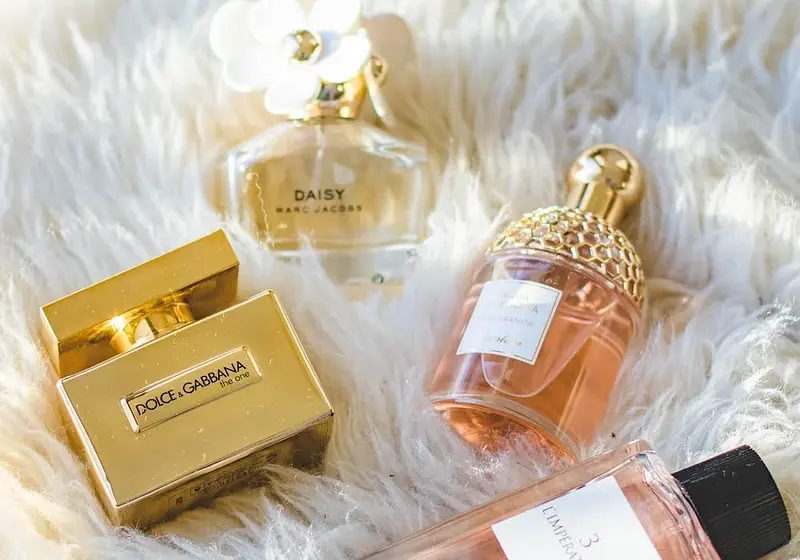If you've been on TikTok as long as I have, you've probably heard of #showertok or #selfcare blowing up everyone's for you page. Whether you're a dedicated viewer of these types of videos or it's your first time even hearing about this genre of TikTok, I'll tell you personally that there is one thing these videos have in common: they usually feature a bunch of fragrances and perfume.
Seeing them could probably overwhelm you, and you feel a need to buy all these scents and run your savings into the ground (I'm also a victim of this). However, as our relationship with self-care and makeup has evolved over the years, I feel like the idea and stability of fragrances have stayed the same.
That being said, it makes sense that you should start looking for fragrances that resonate more with you as individuals, which is where having a signature scent comes in. Your signature scent holds power beyond words, silently etching memories of you in the minds of others and shaping their perception of you. Moreover, it can influence your outlook, setting the tone for the day and reflecting the mood you desire. So, here is your compass to finding a fragrance that embodies your unique identity.
Let us slide into your dms 🥰
Get notified of top trending articles like this one every week! (we won't spam you)Factors to keep in mind when finding your signature scent:
Gender - While fragrance is not strictly confined to gender, certain scents may have traditional associations with masculinity or femininity. Consider whether you prefer fragrances that are more traditionally masculine or feminine or those that transcend gender norms.
Age - Fragrances can evoke different moods and resonate differently at various stages of life. Consider scents that suit your age and personal maturity, whether you lean towards youthful, vibrant notes or more sophisticated and refined compositions.
Fashion and Style - Your signature scent should complement your fashion choices and personal style. You might prefer timeless and sophisticated fragrances if you gravitate towards classic elegance. Those with a more contemporary fashion sense may opt for bold, modern scents.
Personality - Your fragrance should reflect your personality traits. Are you outgoing and vivacious? Consider vibrant and energetic scents. If you are more introspective, seek fragrances that convey depth and contemplation.
Appearance - Consider your physical attributes, such as skin type and coloring. Certain fragrances may interact differently with your body chemistry, so test and select scents that enhance your natural aura and complement your appearance.
Personal Taste - Ultimately, your personal taste is paramount. Explore different fragrance families, such as floral, woody, or oriental, and discover the notes that resonate most with you. Trust your instincts and choose scents you genuinely enjoy and connect with.

Take the Quiz: Which Popular YA Novel Series Should I Read Next?
Find out your next great read after this quiz!
Vocabulary words you need to know:
Sillage - The lingering aura or scent trail that follows you as you move, leaving a subtle fragrance in your wake.
Projection - The extent to which a fragrance radiates and envelops the surrounding space, determining how far away others can detect its scent.
Longevity - The duration or lifespan of a fragrance on the skin or in the air, indicating how long it retains its noticeable scent.
Accord - A harmonious combination of multiple fragrance notes that work together to create a specific olfactory impression or vibe, such as a woody accord or fruity accord.
What's the difference between Eau de toilette and Eau de parfum?
The main difference between Eau de Toilette and Eau de Parfum is their fragrance oil concentration. Eau de Toilette typically contains a lower concentration, around 5-15%, resulting in a lighter and more subtle scent that lasts for a few hours. On the other hand, Eau de Parfum has a higher concentration, usually between 15-20%, offering a stronger and longer-lasting fragrance that can linger on the skin for several hours.
Eau de fraîche - 1-3% perfume oil
Eau de cologne - 2-4% perfume oil
Eau de toilette - 5-15% perfume oil
Eau de parfum - 15-20% perfume oil
Parfum - 20-30% perfume oil
Olfactive families
Selecting your preferred olfactive family is pivotal in discovering your signature scent. Here's a comprehensive list of olfactive families, as it serves as a guide to help you explore and identify the fragrance categories that resonate most with your personal taste and style.
Floral: Embracing the essence of blooming flowers, floral fragrances exude femininity, grace, and elegance.
Subfamilies: Rose, Jasmine, Lily of the Valley, Orange Blossom.
Citrus: Bursting with the invigorating zest of citrus fruits, these fragrances are lively, refreshing, and energizing.
Subfamilies: Lemon, Lime, Orange, Grapefruit.
Oriental: Rich and opulent, oriental fragrances evoke sensuality and exoticism, often blending warm spices, sweet notes, and resins. Subfamilies: Spicy Oriental, Soft Oriental, Woody Oriental.
Woody: Evoking the earthy aroma of forests and woods, woody fragrances exude warmth, sophistication, and a touch of masculinity.
Subfamilies: Sandalwood, Cedarwood, Patchouli, Vetiver.
Chypre: Combining citrus, floral, and woody notes with a touch of mossy undertones, chypre fragrances offer a harmonious blend of freshness and elegance.
Subfamilies: Citrus Chypre, Floral Chypre, Woody Chypre.
Fougère: A classic masculine fragrance family, fougère scents combine fresh herbs, lavender, and woody notes to create a timeless and refined aroma. Subfamilies: Aromatic Fougère, Green Fougère, Floral Fougère.
Aromatic: Aromatic fragrances showcase the vibrant and invigorating scents of herbs, spices, and aromatic plants, delivering a refreshing and uplifting experience.
Subfamilies: Lavender, Herbs, Spices.
Gourmand: Sweet and delectable gourmand fragrances capture the enticing aromas of desserts, confections, and edible treats, invoking a sense of indulgence.
Subfamilies: Vanilla, Chocolate, Caramel, Fruity Gourmand.
Aquatic: Reflecting the refreshing essence of the ocean, aquatic fragrances are light, clean, and reminiscent of sea breezes and water accords.
Subfamilies: Marine, Ozonic, Watermelon, Citrus Aquatic.
Aldehydic: Aldehydic fragrances feature a sparkling and effervescent quality, often combined with floral or fruity notes, adding a touch of sophistication and glamour.
Subfamilies: Floral Aldehydic, Fruity Aldehydic, Citrus Aldehydic.
Note: The categorization of fragrances into families and subfamilies may vary depending on different perfume classification systems.
Accords
Within the vast world of fragrance, while various scent families and facets exist, four general types of accords are composed of different notes.
Fresh: Comprising citrus or watery notes, this accord evokes a refreshing and beach-like ambiance, making it ideal for the summer season.
Amber: Featuring vanilla or incense notes, the amber accord creates an inviting and warm atmosphere with a touch of sweetness. It is perfectly suited for the autumn and winter months.
Woody: Infused with fig, patchouli, and wood notes, the woody accord exudes a distinct masculinity, making it a great choice for the fall and winter seasons.
Floral: Composed of various flowers, the floral accord embodies femininity and is particularly well-suited for the spring and summer months.
Each accord offers a unique olfactory experience, allowing you to align your fragrance with the seasons and personal preferences.
Olfactive Pyramid
The olfactive pyramid is a hierarchical structure used in perfumery to describe a fragrance's different phases or notes. It is also known as the fragrance pyramid or scent pyramid. The pyramid is divided into three layers: top notes, middle notes, and base notes. Each layer represents a different stage in the evaporation process of the fragrance on the skin.
Top Notes: These are the initial and most volatile scents perceived immediately upon application. They create the fragrance's first impression and typically last for about 15-30 minutes. Top notes are usually light, fresh, and citrusy, grabbing attention and inviting further exploration.
Middle Notes (or Heart Notes): The middle notes emerge as the top notes fade. They form the heart of the fragrance, characterizing its personality and providing the main theme. Middle notes develop after the initial application and last for several hours. They are often floral, fruity, or spicy, adding depth and complexity to the scent.
Base Notes: The base notes are the foundation of the fragrance and appear after the middle notes have settled. They are rich, long-lasting scents that linger on the skin for hours or even days. Base notes are typically woody, musky, or resinous, providing depth, stability, and longevity to the overall composition.
The olfactive pyramid is used to understand how a fragrance evolves over time and how different notes interact with one another. It helps in categorizing and describing perfumes and selecting and layering scents to create harmonious combinations. It's important to note that the duration and intensity of each note can vary depending on the fragrance, individual body chemistry, and environmental factors.
Additional Recommendations
Gender: Consider scents like sandalwood, vetiver, and spices for a masculine fragrance. Tom Ford's "Tobacco Vanille" Eau de Parfum is a great option. Try floral scents with hints of rose or jasmine for a feminine perfume, such as Chanel's "Coco Mademoiselle" Eau de Parfum. Unisex fragrances like "Acqua di Gio" by Giorgio Armani offer citrus and aquatic notes that appeal to both genders.
Fashion/Appearance: For a feminine appearance, opt for light and fresh fragrances like Marc Jacobs' "Daisy" Eau de Toilette. Masculine women may enjoy scents with a touch of leather or smoky notes, such as "Black Orchid" by Tom Ford. Match formal attire with sophisticated scents like Dior's "J'adore" Eau de Parfum, while playful scents like Viktor&Rolf's "Flowerbomb" Eau de Parfum suit minimalistic, youthful clothing.
Age: Teens and young adults can try fresh and youthful fragrances like "Light Blue" by Dolce & Gabbana. For ages 25-40, explore scents like "Spicebomb" by Viktor&Rolf for men and "La Vie Est Belle" by Lancôme for women. Older individuals may appreciate sophisticated scents like "Noir de Noir" by Tom Ford or "Gucci Guilty" for men, and "Opium" by Yves Saint Laurent for women.
Personality/Tastes: Confident individuals can opt for bold scents like "Aventus" by Creed, while those who are more introverted may enjoy intimate scents like "Bal d'Afrique" by Byredo. Consider your seriousness and outgoing nature when selecting fragrances. Personalize your scent based on your unique tastes and explore different options to find the one that truly resonates with you.
Note: Fragrance preferences are subjective, and these suggestions serve as a starting point. Experimentation and finding scents that align with your style and taste are key to discovering your signature fragrance.
Finding a signature scent is challenging and sometimes can take time/money, but I hope this guide has helped you figure out what you're looking for so you can be unforgettable in your unique way. Let your signature scent become a fragrant extension of your identity, enhancing your presence and leaving an indelible mark on those around you. Good luck, and let me know if you've found your signature scent in the comments!















